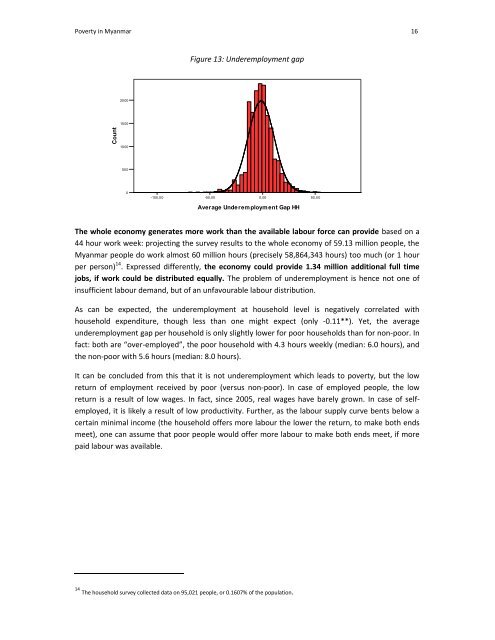A regional perspective on poverty in Myanmar - United Nations ...
A regional perspective on poverty in Myanmar - United Nations ...
A regional perspective on poverty in Myanmar - United Nations ...
You also want an ePaper? Increase the reach of your titles
YUMPU automatically turns print PDFs into web optimized ePapers that Google loves.
Count<br />
Poverty <strong>in</strong> <strong>Myanmar</strong> 16<br />
Figure 13: Underemployment gap<br />
2000<br />
1500<br />
1000<br />
500<br />
0<br />
-100,00 -50,00 0,00 50,00<br />
Average Underemployment Gap HH<br />
The whole ec<strong>on</strong>omy generates more work than the available labour force can provide based <strong>on</strong> a<br />
44 hour work week: project<strong>in</strong>g the survey results to the whole ec<strong>on</strong>omy of 59.13 milli<strong>on</strong> people, the<br />
<strong>Myanmar</strong> people do work almost 60 milli<strong>on</strong> hours (precisely 58,864,343 hours) too much (or 1 hour<br />
per pers<strong>on</strong>) 14 . Expressed differently, the ec<strong>on</strong>omy could provide 1.34 milli<strong>on</strong> additi<strong>on</strong>al full time<br />
jobs, if work could be distributed equally. The problem of underemployment is hence not <strong>on</strong>e of<br />
<strong>in</strong>sufficient labour demand, but of an unfavourable labour distributi<strong>on</strong>.<br />
As can be expected, the underemployment at household level is negatively correlated with<br />
household expenditure, though less than <strong>on</strong>e might expect (<strong>on</strong>ly -0.11**). Yet, the average<br />
underemployment gap per household is <strong>on</strong>ly slightly lower for poor households than for n<strong>on</strong>-poor. In<br />
fact: both are “over-employed”, the poor household with 4.3 hours weekly (median: 6.0 hours), and<br />
the n<strong>on</strong>-poor with 5.6 hours (median: 8.0 hours).<br />
It can be c<strong>on</strong>cluded from this that it is not underemployment which leads to <strong>poverty</strong>, but the low<br />
return of employment received by poor (ver sus n<strong>on</strong>-poor). In case of employed people, the low<br />
return is a result of low wages. In fact, s<strong>in</strong>ce 2005, real wages have barely grown. In case of selfemployed,<br />
it is likely a result of low productivity. Further, as the labour supply curve bents below a<br />
certa<strong>in</strong> m<strong>in</strong>imal <strong>in</strong>come (the household offers more labour the lower the return, to make both ends<br />
meet), <strong>on</strong>e can assume that poor people would offer more labour to make both ends meet, if more<br />
paid labour was available.<br />
14 The household survey collected data <strong>on</strong> 95,021 people, or 0.1607% of the populati<strong>on</strong>.

















